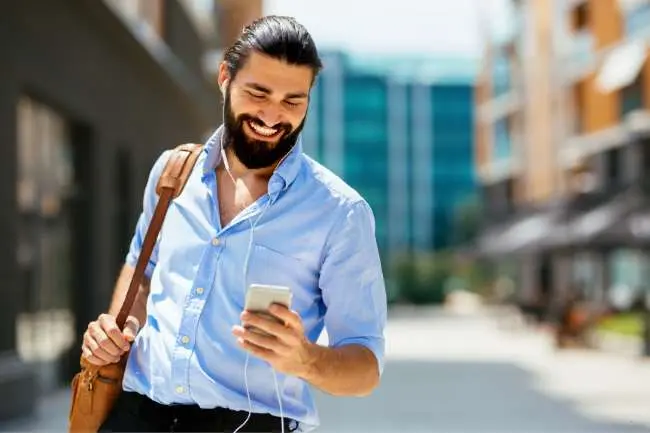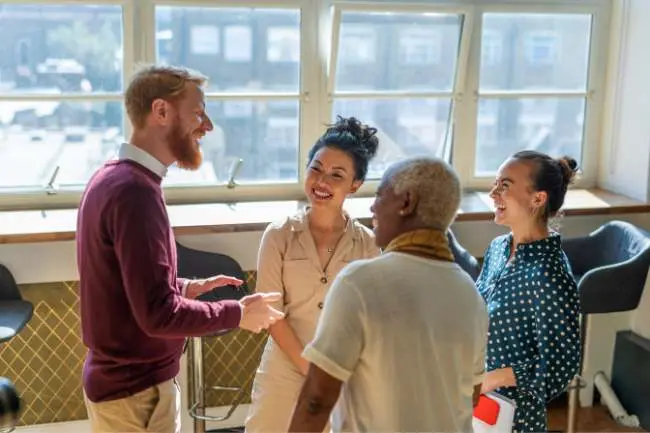The phrase ‘business casual’ is mystifying to many working professionals. Many people want to know what is business casual. Well, business casual is a style of dress that balances business wear and casual dress.
It is the most popular dress code in today’s office environment. This dress code allows employees to work comfortably while still looking professional and being prepared for last-minute meetings or business negotiations.
What is Business Casual?
Business casual is a clothing style that combines a classic business dress code with casual elements. It usually implies a lack of formality. Hence, suits and ties are often excluded, while blouses, polo shirts, khakis, loafers, and the like are applicable. The outfit has to look neat and decent and not ultra-formal.
Importance of Dress Code in Professional Settings
Dress code is the standard for professionalism and personal presentation in the workplace. It can influence client perception and provide a specific standard of decorum within a business setting. In addition, dress codes can increase productivity by decreasing distractions. That is why it is essential to know what is business casual.

Brief History of Business Casual Attire
What is Business Casual? The term “business casual” was coined in the 1990s when companies started to adopt a more relaxed attitude to business attire in general. This was coupled with the twinning technology of the tech space and the expansive creativity of the art space, which allowed comfort and expression.
Evolution of Workplace Attire
What is business casual? Historically, business attire used to be professional and even more classic, with a suit for men, a tie and level shoes. However, as years passed and company cultures became more diverse, dressing became less formal in many places. In the 1990s, ‘Casual Friday’ was introduced and, since then, has spread the vibe of business casual around the entire week for many offices.
Transition from Formal to Casual
More generally, the retreat from entirely formal office wear mirrors the broader changes in office culture such as the rapid growth of “startup culture” and more generally the development and growing importance of the idea of employee well-being and comfort.
Influence of Industry and Geography on Business Attire
Every field and location has its business casual standard. For example, what is considered acceptable business casual for an employee at a Silicon Valley high-tech startup would potentially not pass for one at a Toronto financial institution.
- Examples of Business Casual Clothing
- For men: Polo shirts, sweaters and button-downs are okay for men.
- For women: Conservative tops, cardigans and blouses will be suitable for women.
- Dos and Don’ts of Business Casual
- Do: Keep it neat, tailored and appropriate for the setting.
- Don’t: Don’t wear clothes that are too casual or silly. Avoid wearing flip flops, T-shirts or super-flashy jewelry.
How to Dress Business Casual
As we have learned about what is business casual, it is also essential to understand how to dress it. Here is a complete guide to how to dress business casual for both men and women.
Business Casual For Men
Many people have questions in their minds, what is business casual for men. The semi-formal office environment or casual Fridays are perfect for business casual attire. Business casual is a great way to look comfortable and stylish in the office. Keep the following in your wardrobe to be fully equipped.

1. Shirts
Men’s shirts are an essential part of their business casual outfit.
- Polo shirts or slacks are great combinations that can be paired with trousers to fit informal settings.
- Button-down shirts provide a slightly more formal vibe and can be suitable for business meetings or presentations.
- A neat and well-fitting sweater layered over a collared shirt in the cold still perfectly balances comfort and professionalism.
2. Trousers
The foundation of business casual for men includes trousers such as khakis, chinos, and dark jeans.
- Khakis and chinos are excellent for maintaining a business casual look that is more casual but still looks refined.
- Dark jeans can be appropriate for business casual environments but should be well-fitting and free from distressing or fading, maintaining a polished appearance.
3. Shoes and Accessories
Completing the men’s business casual look involves selecting the right shoes and accessories.
- Loafers are a fantastic shoe choice because they pair well with multiple types of trousers and are easy to wear.
- Belts should match the color of the shoes to maintain a coordinated look.
- A classic watch can also enhance an outfit, adding a touch of sophistication to the overall business casual attire.
What is Business Casual For Women
Women’s business casual attire offers flexibility and variety, allowing for an expression of personal style while adhering to professional standards.
1. Tops
For tops, options include blouses, conservative tops, and cardigans.
- Blouses are a staple in a business casual wardrobe for women, offering a combination of elegance and comfort.
- Conservative tops ensure professionalism and are perfect for layering under jackets or sweaters.
- Cardigans are excellent for keeping warm and can easily be removed to adjust to different temperatures throughout the workday.
2. Bottoms
The right choice of bottoms can define a business casual look. Skirts, slacks, and tailored pants are all appropriate choices.
- To maintain professionalism, skirts should be modest, typically knee-length or slightly longer.
- Slacks and tailored pants in neutral colors such as black, navy, or gray offer versatility and are easy to pair with various tops.
3. Shoes and Accessories
Shoes and accessories should complement the business casual outfit without drawing too much attention.
- Flats and low heels are preferred for their comfort and practicality, particularly for those who need to walk or stand frequently during the day.
- Simple jewelry, such as stud earrings or a delicate necklace, can add a subtle touch of personality to an outfit without being too ostentatious.
Business casual attire serves not only as a bridge between formal and casual wear but also as a reflection of a company’s culture and the nature of its business.
Business Casual for Different Seasons
What is business casual for different seasons? Business casual attire can vary depending on the season, with considerations for both comfort and professionalism. Consider the following guidelines for each season:
Summer Business Casual
When it is warmer, opt for lightweight fabric and light-colored clothes and shoes that reflect the sun’s rays instead of absorbing them, ensuring you’re cool while remaining professional. What is business casual for summer? Linen, lightweight cotton and other equally comfortable options can help you wear work-appropriate attire to the office without breaking a sweat.
Additionally, slippers for men and open-toed, high-heeled sandals as well as boots for women can be a trendy yet reasonable choice. Choosing to wear low-cut socks or going sockless with loafers can give your outfit a summery vibe without making it look less professional.

Winter Business Casual
What is business casual for winter? Winter means layering to cope with the varied outdoor temperatures and indoor heated climates. A good strategy employs a base layer like a cotton turtleneck or shirt, adds a sweater or cardigan and finishes with a lightweight blazer.
Winter accessories like scarves and gloves should be in neutral colors that go with everything else you are wearing. Such items are not only practical for keeping warm; they also build on your overall business casual impression by adding a touch of elegance.
Business Casual Across the Globe
What is business casual attire around the world? Business casual standards are prone to diversity across borders. Considerations of appropriateness in Canada’s business casual may be too informal for Japan where business attire is more conservative.
Cultural traditions shape what is deemed suitable in any workplace ensemble. Some European nations prioritize sophisticated fabrics and meticulous tailoring over volume, preferring quality over quantity in attire.
Meanwhile, in places like Silicon Valley, the approach to business casual can be more relaxed to encourage innovation and a free-thinking environment. Here business dress brings ease and encourages bold brainstorming as professional liberties are welcomed. Yet overall conventions remain that some options simply do not fit every function just as what floats one company’s boat may sink another’s.
Common Mistakes and How to Avoid Them
Dressing for business casual is a tough balance. It is easy to slip up and making those common blunders can hurt you. Avoid the following:
- Inappropriate Lengths: Skirts, dresses, or shorts that are too short will seem out of place in a business casual setting. Aim for modest lengths, just at or slightly above the knee.
- Too Much Skin Showing: The professional standard in most business settings is to cover up and show as little flesh as possible. Deep v-necks, armless dresses with no sleeves or transparent clothing should therefore be avoided at work if professional respectability is your aim.
- Fitting Clothes: Skirts, dresses or shorts that are too short or too long should be avoided. Aim for modest lengths that fall at or slightly above the knee.
- Lack of Grooming: Personal grooming is just as important (or even more so) in business casual settings as it is in formal situations. Pay particular attention to details such as clean and unvarnished fingernails, good grooming and not too flashy make-up or grooming products.
- Overly Casual Clothing: Try to avoid wearing overly casual clothes such as T-shirts, denim jeans or trainers at work, unless you have explicit permission to do so from your employer.
- Disregard Dress Code policies: Always maintain the dress code policies of your company and don’t think “No-essential” because an article of clothing is “casual”. Everything is not appropriate for every ambiance.
- Mismatched Accessories: As it is called demonstrating competence, mismatched accessories are unattractive. Accessories can add flair to an outfit, but be careful not to overdo it. Always select traditional pieces that complement rather than overwhelm your clothing.
Tips for Perfecting Your Business Casual Look
It is necessary to tailor business casual to your own style and taste so that you can feel comfortable and confident. So for this, you should select clothes and accessories that match your personality: in other words, do not wear things with colors or patterns that look wrong on you just because they are fashionable right now; instead, choose items in shades and styles that suit the real you.

- Research the dress code: To know ” what is business casual” means in your office. Also, be sure you take note of what the dress code is at your place of business since the range for corporate attires extends from safe up to the most daring couture. Therefore, see what others are wearing and make a point to follow suit.
- Belt Up: Tight clothes can look slovenly, while baggy garments tend to create first impressions in sync with their sloppiness. Therefore, clothes should fit well but not too tight or loose. Tailored pieces often look better than store-bought clothing.
- No-frill tops: Collared shirts, polo shirts or sweaters are good choices for men. In women’s clothing, blouses or tops not too revealing will give you a professional and self-respecting appearance.
- Angles of vision: Chinos, dress pants or skirts in the right lengths are good choices. Avoid denim unless specifically allowed.
- Lift Your Foot Game: In more formal business casual environments, Closed toe shoes are generally considered more acceptable. There is a no sneakers rule unless it specifically says so.
- Choose Accessories with care: Keep accessories simple and in good taste. Polish your look with items like a watch, belt or subtle jewelry, without being annoying.
- Dress Skillfully: When you wear layers-such as cardigans, blazers and vests-it can move your outfit up a step and help you negotiate shifts in temperature.
- Get in on the action: Good grooming and personal habits are important. Clothing size should appear normal as well: neat hair, clean nails, good makeup or skincare.
- Maintain professionalism: Even in a casually attired environment, you still want to appear business-like and put together. Avoid too peasant or messy dressing.
- Confidence is key: wear your suit with comfortable confidence. If you feel well in what you are wearing, your presence and professionalism will naturally come through.
By employing these tips, you can have a business casual look that’s suitable for the working environment, as well as being beautiful to look at.
Future Outlook for Business Casual Attire
Business casual dress, according to leading forecasting trends, is influenced by the fact that traditional industries have embraced more casual attire in response to the tech business’s culture of laid-back dress rules.
Emerging trends of remote work influenced by COVID-19, many companies and employees have redefined business casual to focus on the upper part of their body as a result of regular video calls.
Conclusion
To understand what is business casual entails is fundamental for navigating professional environments confidently and with style. Business casual attire serves not only as a bridge between formal and casual wear but also reflects a company’s culture, as well as income sources. Understanding and adhering to your company’s definition of business casual will give you professionalism that gains respect in a professional environment.
Frequently Asked Questions
How do I Dress for a Work Casual event?
Business casual is a dress code that blends traditional business wear with a more relaxed style suitable for a professional office environment.
Is it true that jeans are work casual?
Business casual jeans must be free of damage and dark. When paired with a professional top and fashionable shoes, it is OK to wear them to work.
What is business casual outfits can we see on a man?
For men, business casual attire typically includes polo shirts, button-down sweaters, khakis or chinos; dark jeans and loafers or business shoes.
What is business casual attire for a woman should be?
Women can wear button-down shirts, conservative tops, cardigans, tailored pants, knee-length skirts and closed-toe flats or low-heeled shoes.
Can I wear sneakers in a work casual wardrobe?
Sneakers can be acceptable, but only if they are clean and in good condition. Especially in more casual or creative professions.
How should I dress for Interviews in a business casual environment?
Choose a slightly more formal version of business casual, such as a blazer and a good pair of trousers or skirts, to convey professionalism.
Is a tie required with work casual attire?
Ties are not often needed for business casual attire, although adding a tie may make your overall look more formal. This is particularly useful in formal situations surrounded by anyone wearing suits.
How do changes in seasons affect work casual clothes?
Seasonal changes mainly affect the layering and warmth of your business casual clothes with lighter colors in spring or summer.
What is business casual attire’s common mistakes?
The biggest mistake is to go too casual and forget the “business” in “business casual”. People look sloppy and unprofessional when they don’t present well-groomed attire.














